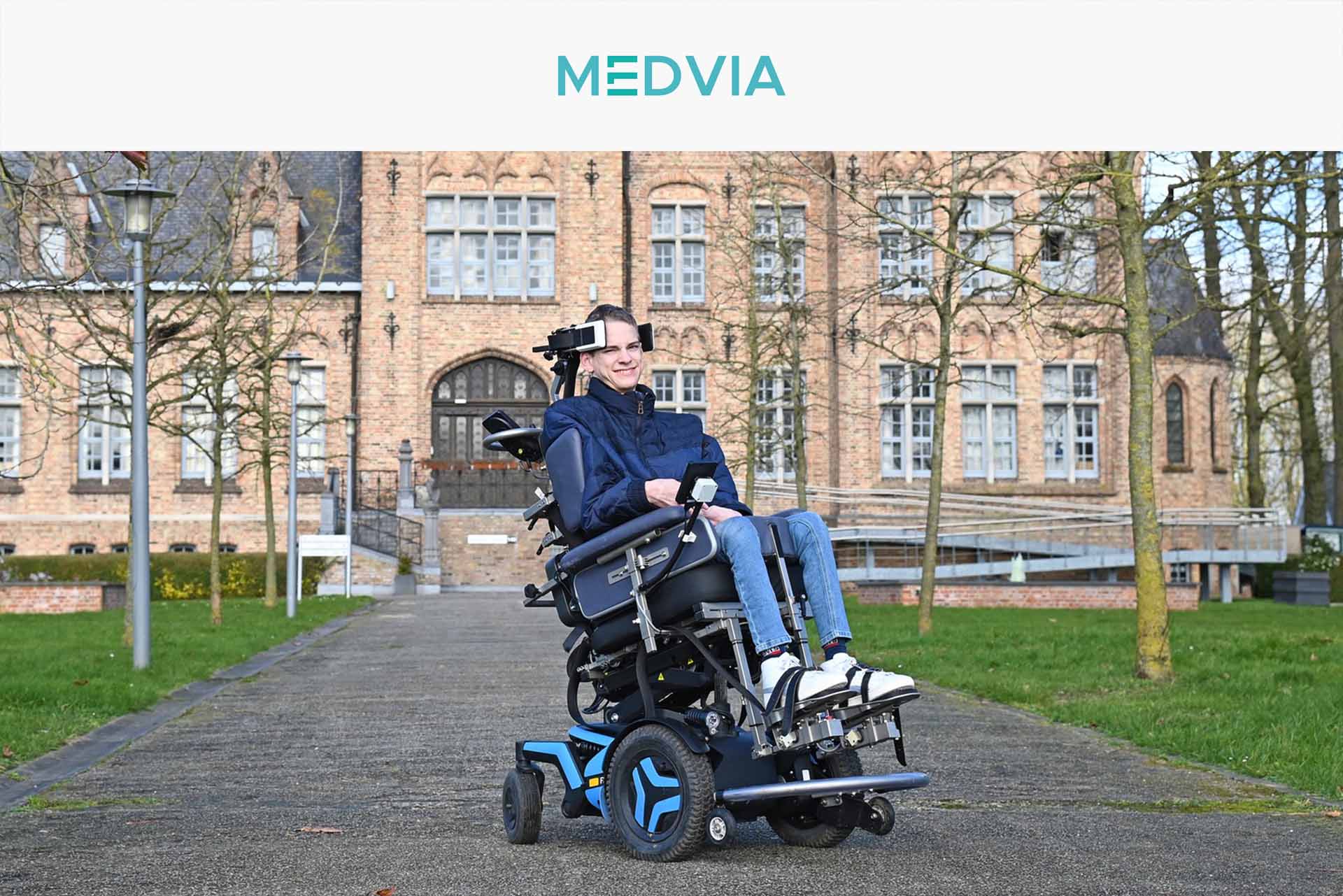Header Image: Levi Rijsbrack (courtesy of CoMoveIT).
In the early 2000s, Prof. Dr. Elegast Monbaliu was working as a therapist for people with complex movement disorders. He was struck by how much the involuntary movements of his patients restricted their ability to move around independently using standard mobility aids such as powered wheelchairs. People with severe dyskinetic cerebral palsy, for example, would have a hard time operating the joystick that is typically used to control a powered wheelchair. This observation awakened his desire to develop a more suitable steering system to meet these people’s needs.
“Many had resigned themselves to the idea that a mobility solution for people with complex movement disorders – especially cerebral palsy – was impossible to find.” – Sotirios Gakopoulos
“His ambition was met with skepticism by physicians and therapists, as previous attempts had all failed to live up to their expectations,” Gakopoulos explains. “By then, many had resigned themselves to the idea that a mobility solution for people with complex movement disorders – especially cerebral palsy – was impossible to find.”
The right partners for success
Most of these earlier attempts had focused on ways to make it easier for a person with a complex movement disorder to use a traditional joystick. Instead, Prof. Monbaliu saw greater potential in a system that enables users to steer using their head and feet, over which they typically have more control.
“It took until 2017 for his idea to come to fruition, when a research project took place in KU Leuven where his clinical expertise was complemented by the technical know-how needed to develop such a device,” Gakopoulos says. “The range of motion of the hands, arms, legs, and head of cerebral palsy patients was studied at the lab of Prof. Jean-Marie Aerts, and these insights were then used by the lab of Prof. Hans Hallez (where I was hired as a PhD student), to inform the development of optimal electronics, pressure sensors, and firmware for the head and feet.”
An agile AI system
Earlier systems had already used buttons controlled with the body or the head, but their applicability was limited as they required a constant time-consuming adjustment. “Say for example that a system is adjusted or calibrated in the morning: that system becomes increasingly less effective throughout the day, as the characteristics of the involuntary movements and the pressure that users can apply to activate a system change. This means we needed to develop a solution capable of automatically adapting to the needs of the user over time.”
“We needed to develop a solution capable of automatically adapting to the needs of the user over time.” – Sotirios Gakopoulos
The researchers achieved this adaptive solution using a simple form of artificial intelligence. “Our algorithm is somewhat atypical, in the sense that it doesn’t use or store large amounts of data,” Gakopoulos explains. “But since the involuntary movements are so random and unpredictable, keeping track of how much pressure the user is applying to the sensors every a few seconds is sufficient to be able to dynamically adjust the system.”
A life-changing solution for many
By the project’s conclusion in 2020, a prototype had been developed. The new device, named CoMoveIT-Smart, was extensively tested to determine if it was safe, reliable, and effective for people with complex movement disorders. “As soon as we saw how well the system performed, we started looking for investors,” Gakopoulos says. “But because all of us are from an academic background, we lacked the industrial experience to bring the product to the market. Luckily, we found the ideal Co-founder and CEO for CoMoveIT in Frederik Vervenne, who has a track record of more than 25 years of experience.”
CoMoveIT was founded in July 2021 as the first spin-off of KU Leuven Brugge, and delivered its first product to the end users already the following year. With an initial focus on severe dyskinetic cerebral palsy, the company’s solution has the potential to positively impact the lives of 7,000 people in Belgium alone, with a further 600,000 in Europe and North America.
“Currently, we have end users in Belgium, The Netherlands, and Germany,” Gakopoulos states. “In the coming months, we are rapidly expanding to new countries including Finland, the United Kingdom, New Zealand, and Ireland. We are currently only targeting countries where these types of systems are fully reimbursed, or where there are charities willing to cover the costs.”
Patient-driven development
From the start, CoMoveIT has maintained the importance of involving end users in the product development process. “We believe it is essential to interact closely with the end users in order to really understand their needs,” Gakopoulos affirms. “This means we collect feedback from patients, therapists, parents, and caregivers, using this information to continuously improve the technology.”
This patient input also includes CoMoveIT’s in-house expert Levi Rijsbrack, one of Prof. Monbaliu’s former patients who has since joined the company (watch this video for a demonstration of Levi using the CoMoveIT Smart steering system). “Levi works closely with the rest of the team, helping us understand the needs of our end users by sharing his day-to-day experiences and the difficulties he encounters. He is also the first to test out any improvements we make to the product. Together with Levi, we are not only implementing mobility-related improvements, but are also working on expanding the capabilities of the device.”
Read this article to find out more about how to improve patient-driven innovation!
CoMoveIT’s goal is to create an interface with the broadest possible range of devices, from (gaming) computers to smartphones and home automation. “This would mark another important step in enabling people with complex movement disorders to communicate and participate in society,” Gakopoulos concludes. “While our initial ambition was to improve people’s mobility, our technology could also be further developed into a range of tools to help improve the quality of life for people with complex movement disorders.”


